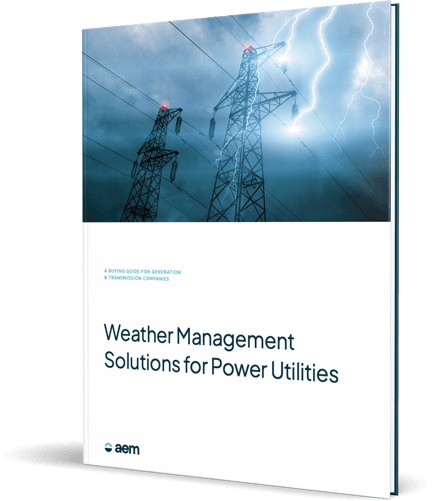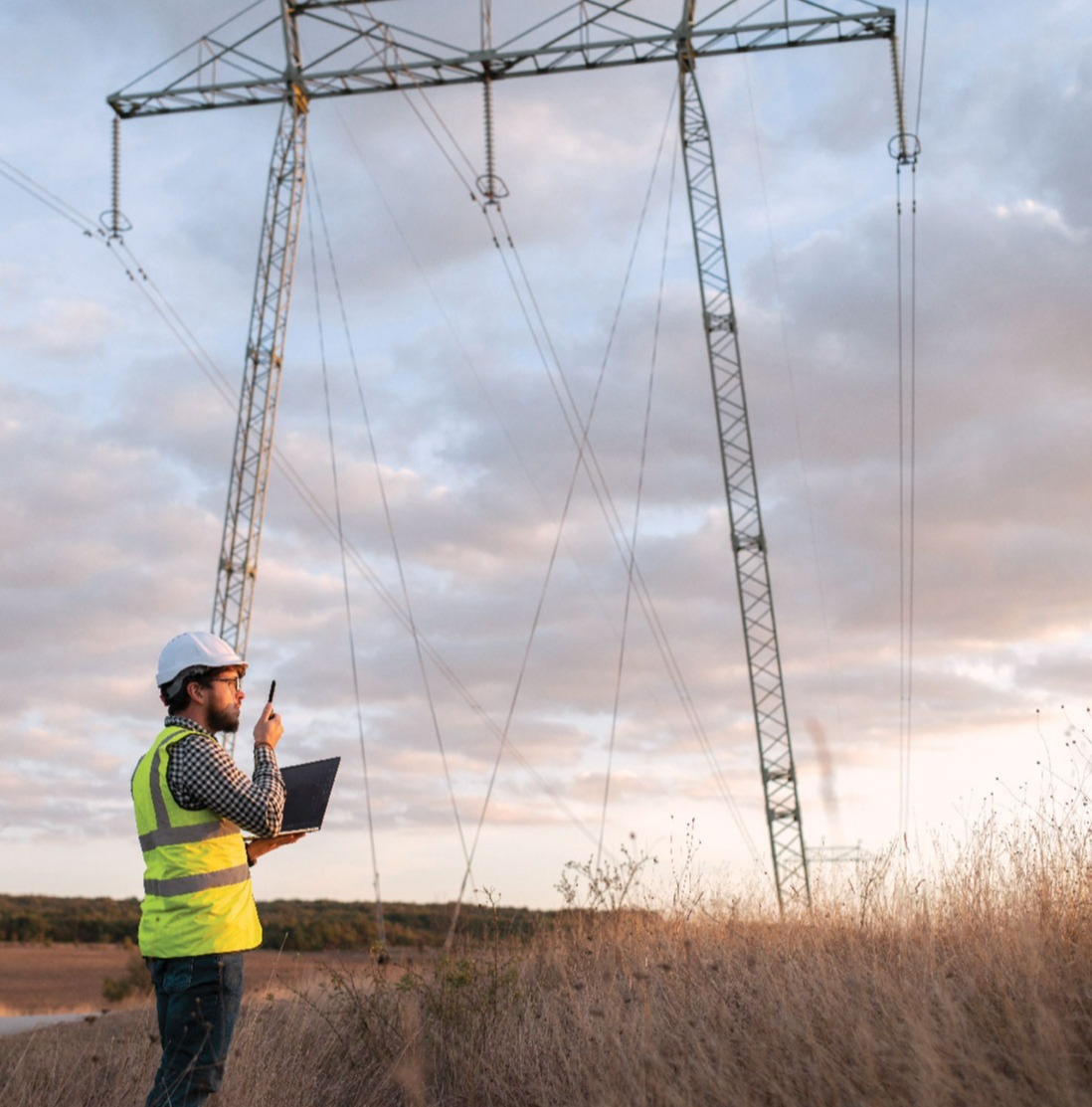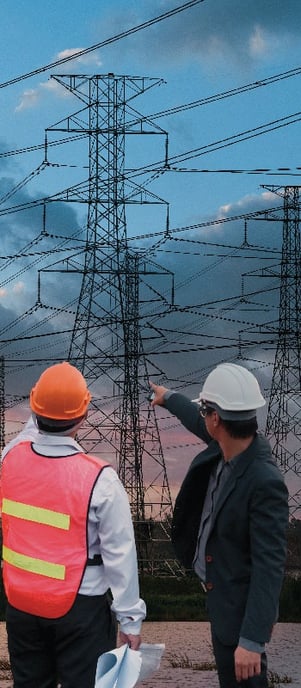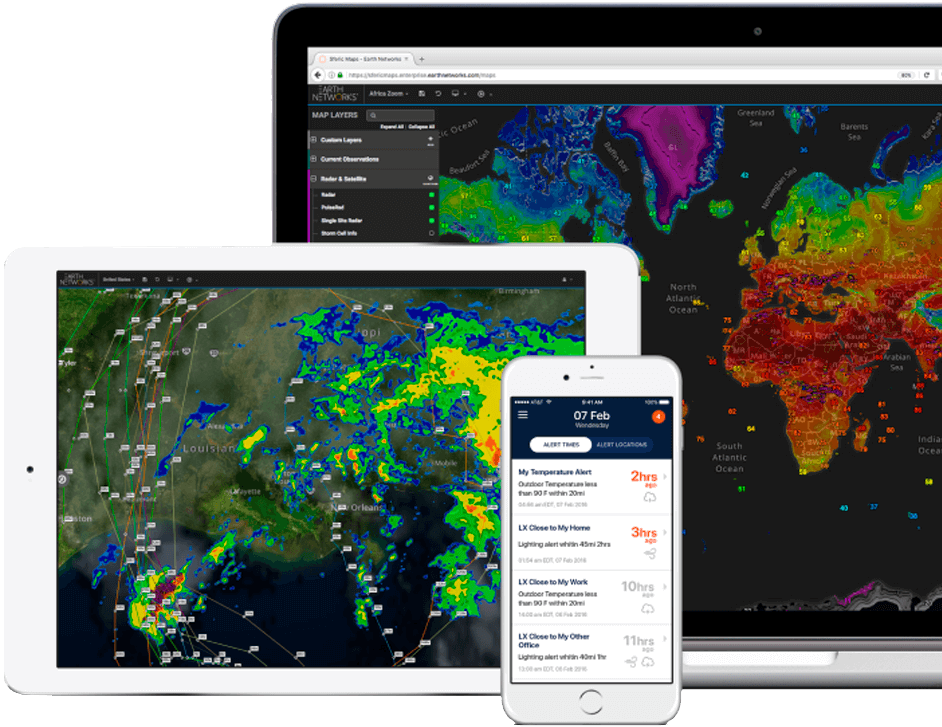A BUYING GUIDE FOR GENERATION & TRANSMISSION COMPANIES:
Weather Management Solutions for Power Utilities

Power and energy utilities have the responsibility of providing electricity to keep people safe, warm, fed, and alive. Whether you’re an Investor-Owned Utility (IOU), a municipal provider, or part of a rural co-op, you need to protect your infrastructure, communicate with your customers, and provide services in a consistent way that people can believe in.
In this buying guide we will cover the following topics:
Send me the buying guide!
Three stages of developing an effective weather policy
Building the ideal weather monitoring and alerting solution for your utility requires a deep understanding of your specific needs, service area, and existing operating procedures. Over the last 25 years, we've found that an effective approach to mitigating weather risks includes three easy-to-remember stages:
Analyze, Plan, and Implement.
STEP ONE
Analyze
The first step toward total weather preparedness is understanding exactly where the risks, exposures, and potential losses exist in your current approach. You can refer to the worksheet at the end of this guide to help inform and structure your analysis.
ASSETS OR EXPOSURES
Who or what are you trying to protect? Think of different kinds of people and assets that could be damaged, injured, or put at risk by weather.
ACTIVITIES AND EVENTS
What activities put the people and assets you just mentioned in danger? Think about which standard procedures, routines, and work could be disrupted or made unsafe by severe weather conditions.
THREATS POSED BY WEATHER VARIABLES
What specific weather events are you most susceptible to, or how could weather escalate a small problem? Think about what kinds of weather affect your service area frequently, which occur with some regularity, and which are “freak” events that need to be prepared for.
LEGAL & REGULATORY GUIDELINES
What FERC regulations or local laws is your utility beholden to with regard to weather monitoring and emergency management?
EMERGENCY RESPONSE
Who will lead whom and what is the chain of command during a given weather-related emergency? How will you communicate and collaborate with customers, response agencies, and others? How will you assess your response?
STEP TWO
Plan
The second step is drafting a practical, actionable plan for weather monitoring, threat detection, and response planning based on the analysis you’ve carried out. This stage includes three basic steps:
TRACKING YOUR REQUIREMENTS
Once you’ve completed your analysis from Step 1, review your worksheet in detail to uncover exactly what your plan needs to address, account for, and make clear. Think about which different events, teams, scenarios, and collaborative structures you absolutely need to include and spell out in detail.
DEVELOPING A PLAN OF ACTION
Your plan of action should include the following:
- Your written weather safety protocol, detailing each of your identified risks or exposures and how your team will address them (including a critical alert radius for incoming weather, proactive communication plan for customers
and emergency response agencies, and procedures for protecting personnel and infrastructure as needed) - Your weather monitoring and alerting solutions (tools, software, and support services that keep you informed on developing weather and ensure your team is aware of any potentially hazardous incoming conditions)
DETAILING AN EFFECTIVE COMMUNICATION STRATEGY
Communication is crucial to ensuring everybody’s safety and minimizing the damaging effects of power service interruptions. Be sure your plan accounts for how you’ll…
- Prepare customers for incoming dangerous weather
- Provide a clear chain-of-command during weather emergencies
- Communicate restoration timelines during outages

Getting Started
Across each step of the process, there are key questions that need to be answered to ensure across-the-board severe weather preparedness for your team. Download the buying guide for an interactive worksheet that will help you carry out your analysis and begin to map your plan.
STEP THREE
Implement
Once you’ve built a clear plan for tracking, responding to, and communicating about weather emergencies, it’s time to put that plan into action. Below is an implementation checklist that should help you get up and running:
Disseminate policies and procedures internally
Share and validate policies and procedures with collaborating response agencies
Educate your customers about weather threats and your proactive approach

Key features of a weather monitoring and management system for power utilities
A weather-ready utility relies heavily on thorough safety protocols, advanced monitoring and alerting technologies, and the established expertise of professional meteorologists.
Meeting utility providers’ increasingly complex monitoring and response needs requires a complete weather management toolkit made up of the following components.
Click the specific panel below to learn more about how these features can transform your power utilities
A real-time weather map and mobile app combination enables you to plan for incoming weather events and keep at-risk stakeholders safe. Interactive weather maps visualize data in real time with animated layers and storm “time of arrival” estimates to help you prepare for anything that comes near your service area.
You can display the weather map on a centrally located display – like in your Operations Center – or keep it on your desktop for easy access. The addition of a companion mobile application ensures that you will always have access to the map information and alerts and can easily extend that information to your colleagues in the field. Used in combination, these tools create a central source of truth for utilities, municipalities, and emergency response agencies to have access to the same weather information at the same time.
What to look for?
Reliable sources of data from a professionally managed network with incident analysis capabilities and up-time guarantees
What to look for?
Modeling that’s backed by real meteorologists you can contact for clarification, assistance, etc.
What to look for?
Systems that aggregate multiple sources of information (so you don’t have to manually review and compare them) for current, forecast, and historic weather information
What to look for?
Multi-channel alerting that supports desktop and mobile devices from the same alerting center
What to look for?
Solutions that provide a clear up-to-the-minute visual and audio that enables at-a-glance interpretation

With on-demand meteorological services, you gain access to a team of meteorologists who can help you understand current conditions better, prepare for incoming weather, or plan your response. By forging a partnership with a true expert, you can leverage a powerful resource to help during those crucial moments when interpreting a forecast correctly can be the difference between total operational continuity and a potentially damaging, costly service interruption.
Professional meteorologists can also help you understand how current or incoming weather events will affect fluctuations in energy demand. That knowledge can potentially save a utility millions of dollars while maximizing customer safety and satisfaction.
What to look for?
24/7/365 coverage so your team can consult meteorologists at any time as needed
What to look for?
Customizable dashboards and data views you can use to digest weather data and meteorological guidance
What to look for?
A collaborative team of professional meteorologists that meet, confer, and check forecast data to ensure accuracy and quality
What to look for?
Services with meteorologists who understand the utility industry and can help you plan for weather-related demand spikes
What to look for?
Meteorologists that rely on multiple forecast models and hyperlocal observational data to give you the most accurate, specific information
Lightning is one of the biggest threats to power utilities because of its ability to damage infrastructure through direct strikes as well as start wildfires. That’s why understanding where and when lightning is striking or approaching your service area is crucial. With a lightning alert system, you can gain insights into dangerous electrical storms that will help you and your colleagues at local emergency response agencies minimize the impact of lightning in your area.
A strong lightning alert system involves several elements: access to real-time lightning maps for storm tracking and preparedness as well as sirens and strobe systems that can be used at key locations to alert workers to incoming storms. With that blend of technologies, you can minimize risks to your workers and the public while maximizing your ability to respond to potential small fires or repair damaged equipment in a timely manner.
What to look for?
Systems that use robust network-based weather technology to pull information from vast networks. Unlike single-node tools, network-based weather solutions capture information from multiple sources for a clearer picture of actual conditions
What to look for?
Customizable alert ranges that allow you to set your own lightning parameters and identify your areas of highest interest
What to look for?
The latest systems provide a countdown clock so all relevant decision-makers and stakeholders in the field can understand when the lightning risk will pass and when work can be resumed safely
What to look for?
Systems that support multi-channel alerting with email, text, and/or push alerts to ensure everybody gets the message about incoming weather

Learn about weather management solutions for power utilities.
Download the free buying guide.
Download GuideIt’s crucial for you and your local fire departments and wildlife management agencies to know immediately when a lightning strike or other source has created a fire in your service area. Each moment is precious when it comes to containment, protecting infrastructure, and maintaining public confidence.
Strategically placed high-definition cameras allow your team to scan your service area for smoke, heat, or visible fire from a central command center or any network-enabled device. That live look into the field maximizes threat visibility and accelerates your response to save lives, protect infrastructure, and ensure continuity of service.
What to look for?
Cameras with real-time high-definition video, to provide the clearest possible picture and greatest possible response time
What to look for?
360-degree field of view, to minimize the number of cameras you’ll need to create a comprehensive network
What to look for?
Zoom capabilities and remote camera control, to provide your team with the most possible visual data from a safe distance
What to look for?
Multi-channel alerting, to maximize fire visibility and facilitate coordination and communication with other agencies
Like wildfires, floods are becoming more frequent and more damaging in many parts of the country. To maximize safety in your community and protect infrastructure, you need to know when and where floods are beginning to develop and when water levels reach limits that could threaten your customers, workers, or generation equipment.
Furthermore, if your utility uses hydroelectric dams for generation, it’s crucial that your team is able to monitor water conditions above, below, and inside your dams to ensure proper operations and the safety of neighboring communities.
Early warning of rising waters can provide your team with valuable time to warn the public of a dangerous flood, plan mutual response with outside agencies, and execute planned power cuts to maximize safety for consumers and emergency response professionals during and immediately after the flood.
What to look for?
Solutions that provide a balance of hyperlocal and regional conditions to provide a full picture of current and incoming weather
What to look for?
Clear, multi-channel limits-based alerts and notifications to maximize communication and collaboration
What to look for?
Flash flood alerts that buy your team time to lead and make decisions
What to look for?
All-clear messages to maximize operational continuity
What to look for?
Monitoring tools designed specifically for use near dams, to provide the most accurate possible assessment of conditions

Next Steps
Download the guide for an interactive worksheet to make a plan and take action.
Download GuideCHECK WITH INDUSTRY RESOURCE GROUPS & MEMBER ORGANIZATIONS
To identify weather services vendors for consideration, start by consulting industry associations (AEIC, EEI, NRECA, etc.), trade publications, and your peers. Unlike a resource like project management software, there are not any review sites for weather services providers.
The U.S. National Weather Service maintains a list of Enterprise Resources at NWS Enterprise Resources (weather.gov) but does not endorse or recommend any specific providers or solutions. You’ll have to vet them yourself and decide which vendor and solution will be the best fit!
CHECK CUSTOMER REVIEWS
Reading or listening to customer testimonials is a great way to hear what others really think about the vendors and their weather tracking, alerting, and/or forecasting solutions.
MAKE SURE THEY SUPPORT YOUR A-P-I
You’ll also want to clearly understand your needs for a weather solution using the Analyze-Plan-Implement framework outlined earlier in this guide to make sure any vendors you are considering offer all of the services you need.
DO RESEARCH & REQUEST PROPOSALS
Once you’ve identified a shortlist of vendors, invite each of them to respond to your requirements. You’ll want to review presentations, product demonstrations, and other support materials like white papers, eBooks, datasheets, and so on. This can be as formal (or informal) as fits your organization, but clearly communicating your objectives and requirements is imperative.
EVALUATE TOP CONTENDERS
You’ll want to look for the appropriate balance of weather data source quality, alerting methods, and customer support. We’ve drafted some suggested questions and evaluation criteria for you to use. The requirements on the next page do not represent an exhaustive list of key capabilities but are a helpful starting point.
Transform your business with AEM.
Get in touch




